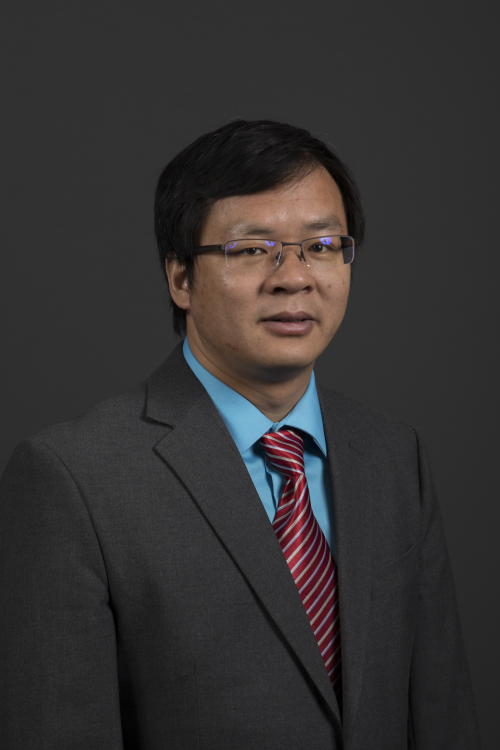NSUF Article
NSUF Researcher Feature: Haiming Wen

“The materials in a nuclear reactor are the key to the development and deployment of advanced nuclear reactors,” Wen said. “We want to improve the radiation performance of the materials such as steels.”
The approximately $3 million innovative project funded by the U.S. Department of Energy’s Office of Nuclear Energy started in October 2016 and runs through September 2023. Researchers anticipate removing the first batch of steel samples, about half of total inventory, in FY 2019 after a year in the ATR. The remaining half will stay in ATR for another year for a higher neutron dose to cause even more intense damage for researchers to examine and compare.
Most specimens are different types of steels (304, 316, T-91 and FeCrAl) intended for use as structural materials and fuel cladding in nuclear reactors. These steels, some of which were engineered by Wen and his team, have different internal microstructures than commercial steels. They are ultrafine grain steels (grain size larger than 100 nanometers and smaller than 1 micron) or nanocrystalline steels (grain size smaller than 100 nanometers), where 1 micron is one millionth of a meter and 1 nanometer is one billionth of a meter. In contrast, commercial steels are coarse grained (grain size typically larger than 10 microns).
Grains are internal structural units in material, and the borders between units are called grain boundaries. Neutron irradiation damages the materials, causing many defects. The grain boundaries act as sinks, absorbing the irradiation-induced defects. The smaller the grain size, the greater the number of grain boundaries, and the less accumulated damage or defects in the materials, making the materials more durable in the harsh environment of a reactor.
In addition to studying steels, the team is also studying and engineering high entropy alloys, which have internal structures that are inherently random and disordered. Unlike traditional materials such as steel, where atoms occupy different sites in an ordered and consistent way, in these high entropy alloys, the arrangement of atoms is random. The structures of high entropy alloys are more stable during neutron irradiation because the neutrons don’t significantly impact the already disordered structures. The unique structure and composition of high entropy alloys make them less susceptible to neutron damage.
Besides Wen, three scientists from INL (James Cole, Yongfeng Zhang, and Isabella van Rooyen), and two Missouri S&T doctoral students (Andrew Hoffman and Maalavan Arivu), are working on the project along with Jiaqi Duan, a postdoctoral researcher. In addition, NSUF program staff and INL staff scientists are supporting the neutron irradiation and post-irradiation examination work including Keith Jewell, Katie Anderson, Michael Sprenger, Bryon Curnutt, Stacey Wilson and Cody Hale.
After the steels are removed from the ATR, they are radioactive (hot) because of the neutron irradiation, and “cool down” takes several months. Then researchers start the post-irradiation examination including microstructural characterization. By studying the damage and underlying mechanisms, researchers can determine the steel that is most resistant to neutron damage and learn how to tailor the microstructure of the steel to further increase resistance.
In addition, researchers perform mechanical testing on the irradiated samples, evaluating their mechanical strength (how much load the samples can withstand) and ductility (how much deformation they can sustain).
Because the microstructures of the samples are so small, invisible to the human eye, researchers need cutting-edge technology and instruments to understand both the nanostructures of the steel samples and the defects caused by neutron irradiation.
Researchers use the focused ion beam technique in a scanning electron microscope, which involves one ion beam and one electron beam. The ion beam acts like a knife to cut and prepare specimens, and the electron beam is used to image the whole micromachining process so researchers can see what is going on exactly. Once cut to size, these specimens are ready for transmission electron microscopy (TEM) and atom probe tomography (APT), which provide very advanced and detailed images with ultrahigh resolution down to each atom (and in 3D in the case of APT) so that researchers can accurately and thoroughly understand what the neutrons did to the steels’ microstructure.
The TEM transmits a beam of electrons through the sample to form an image, which is then magnified and focused onto a screen or film for viewing and capturing the microstructure of the sample, thereby detecting neutron damage to the sample.
APT involves fabricating nanometer-sized sharp tipped needles of the samples, field evaporating atoms off via electric laser pulses that travel down a highly curved electric potential detecting the individual atoms and then recreating an image of how the atoms were distributed in the material.
These studies will take several years because of the volume of materials to examine. Some samples won’t get examined and will go to NSUF’s Nuclear Fuels and Materials Library (NFML), an archive of irradiated samples that are available for additional research projects to researchers nationwide. Once in the NFML, other researchers can study the materials without the incurring the expense or time needed for neutron irradiation.
Before the samples were loaded into the ATR and subjected to neutron damage, researchers prepared and characterized the samples. Wen said his team and collaborators developed and fabricated the ultrafine grain and nanocrystalline steels and advanced high entropy alloys while the conventional coarse-grained steels were commercial products. Wen and the others have published three papers, submitted two others, and have more in preparation that look at preirradiation characteristics of microstructure and mechanical behavior.
“We want to improve materials used in nuclear reactors to make nuclear energy even more reliable, efficient and cost-effective,” Wen said.
Articles
About Us
The Nuclear Science User Facilities (NSUF) is the U.S. Department of Energy Office of Nuclear Energy's only designated nuclear energy user facility. Through peer-reviewed proposal processes, the NSUF provides researchers access to neutron, ion, and gamma irradiations, post-irradiation examination and beamline capabilities at Idaho National Laboratory and a diverse mix of university, national laboratory and industry partner institutions.
Privacy and Accessibility · Vulnerability Disclosure Program

